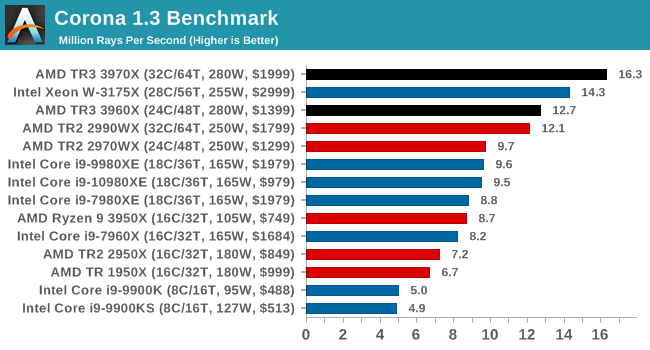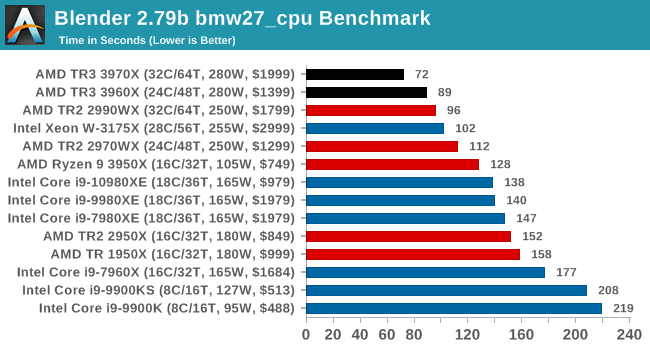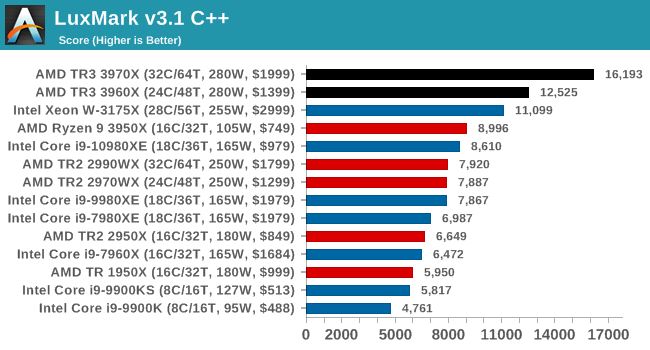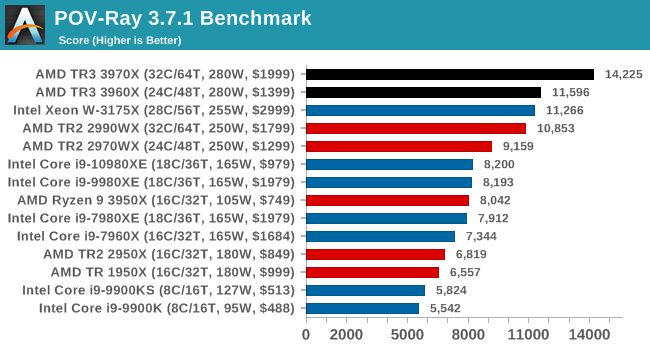The AMD Ryzen Threadripper 3960X and 3970X Review: 24 and 32 Cores on 7nm
by Dr. Ian Cutress, Andrei Frumusanu & Gavin Bonshor on November 25, 2019 9:05 AM ESTCPU Performance: Rendering Tests
Rendering is often a key target for processor workloads, lending itself to a professional environment. It comes in different formats as well, from 3D rendering through rasterization, such as games, or by ray tracing, and invokes the ability of the software to manage meshes, textures, collisions, aliasing, physics (in animations), and discarding unnecessary work. Most renderers offer CPU code paths, while a few use GPUs and select environments use FPGAs or dedicated ASICs. For big studios however, CPUs are still the hardware of choice.
All of our benchmark results can also be found in our benchmark engine, Bench.
Corona 1.3: Performance Render
An advanced performance based renderer for software such as 3ds Max and Cinema 4D, the Corona benchmark renders a generated scene as a standard under its 1.3 software version. Normally the GUI implementation of the benchmark shows the scene being built, and allows the user to upload the result as a ‘time to complete’.
We got in contact with the developer who gave us a command line version of the benchmark that does a direct output of results. Rather than reporting time, we report the average number of rays per second across six runs, as the performance scaling of a result per unit time is typically visually easier to understand.
The Corona benchmark website can be found at https://corona-renderer.com/benchmark

Being fully multithreaded, we see the order here follow core counts. That is except for the 32-core 2990WX sitting behind the 24-core 3960X, which goes to show how much extra performance is in the new TR generation.
Blender 2.79b: 3D Creation Suite
A high profile rendering tool, Blender is open-source allowing for massive amounts of configurability, and is used by a number of high-profile animation studios worldwide. The organization recently released a Blender benchmark package, a couple of weeks after we had narrowed our Blender test for our new suite, however their test can take over an hour. For our results, we run one of the sub-tests in that suite through the command line - a standard ‘bmw27’ scene in CPU only mode, and measure the time to complete the render.
Blender can be downloaded at https://www.blender.org/download/

We have new Threadripper records, with the 3970X almost getting to a minute to compute. Intel's nearest takes almost as long, but does only cost half as much. Again, the 3960X puts the 2990WX in its place.
LuxMark v3.1: LuxRender via Different Code Paths
As stated at the top, there are many different ways to process rendering data: CPU, GPU, Accelerator, and others. On top of that, there are many frameworks and APIs in which to program, depending on how the software will be used. LuxMark, a benchmark developed using the LuxRender engine, offers several different scenes and APIs.
In our test, we run the simple ‘Ball’ scene. This scene starts with a rough render and slowly improves the quality over two minutes, giving a final result in what is essentially an average ‘kilorays per second’.

Our LuxMark test again pushes both TR3 processors out in the lead.
POV-Ray 3.7.1: Ray Tracing
The Persistence of Vision ray tracing engine is another well-known benchmarking tool, which was in a state of relative hibernation until AMD released its Zen processors, to which suddenly both Intel and AMD were submitting code to the main branch of the open source project. For our test, we use the built-in benchmark for all-cores, called from the command line.
POV-Ray can be downloaded from http://www.povray.org/

More rendering, more wins for AMD. More losses for the 2990WX, even though on these tests it still beats the 10980XE quite easily.











245 Comments
View All Comments
PeachNCream - Tuesday, November 26, 2019 - link
Very much agree with this statement. Desktops are a shrinking market segment. Mainstream home users and corporate office computing assets are generally now laptops regardless of whether or not the mobility makes sense or is a necessity. Yes, there is a market for desktop computers and that market does include massively parallel workloads that benefit from lots of cores/threads, but the center of mass in terms of money in CPU sales has shifted to portable computing where AMD is still lagging due mainly to power consumption and heat output. The I/O die design AMD uses is not so great in that sense and Intel still has an advantage in the mobiel sector.Xyler94 - Tuesday, November 26, 2019 - link
Both of you are actually wrong.Intel doesn't care about laptops, it's a side project basically. Both Intel and AMD want Server space. Servers are the heart of the market. Especially Supercomputers. Intel wouldn't care one bit if AMD took 25% of the laptop market, but you can see Intel scrambling and panicking at every single percent AMD gains in the Server Market.
Laptop CPUs are so little margin, Intel wouldn't actually care if people buy AMD. Servers and HEDT processors are such high margin, they'd rather 1 person buy a Xeon or 2066 processor than 10 people buying laptops. It's all about profits, not units sold.
PeachNCream - Tuesday, November 26, 2019 - link
Have you looked at Intel and/or AMD's income breakdowns out of their financial reports? I have. You're assertion is not correct.Korguz - Tuesday, November 26, 2019 - link
" Desktops are a shrinking market segment " im not so sure about that... no one i know wants a notebook, for portability, they have their phones or tablets for that...upanddown - Monday, November 25, 2019 - link
Your revenue numbers don't mean anything. 15 years ago Nokia was also unbeatable, as well as Yahoo, MySpace etc..For Intel, there is a chance that similar to "after-Athlon" era will never come again.
Xyler94 - Monday, November 25, 2019 - link
Especially since the bribes are what made Intel keep goingdrothgery - Monday, November 25, 2019 - link
No, what made Intel keep on going was AMD's lack of manufacturing capacity (they couldn't have supplied much more than 25% of the CPU market in the Athlon 64 X2 era even if they wanted to), inferior laptop CPUs, and lack of infrastructure to support their server/workstation CPUs. Since going fabless, they're nowhere near as capacity constrained now, and may have more of the server infrastructure figured out... but Zen 3 doesn't have anywhere near the advantage on 10th-gen Core that Athlon 64 X2 derivatives had on Pentium 4 derivatives, either.If Intel can get cores/$ and total core counts reasonably close to EPYC and TR (which is likely), they'll be fine in the long run.
Korguz - Monday, November 25, 2019 - link
drothgery you didnt hear about how intel would bribe and threaten OEMs and the like NOT to use amd products ? thats what hurt amd way back when, thats why intel payed a billion or so to amd to settle that.. what advantage ?? zen 2 has more IPC then intel, why do you think intel needs such high clock speeds to compete with lower clocked cpus ??Xyler94 - Tuesday, November 26, 2019 - link
You don't know the history of the mid 2000s, do you?drothgery - Tuesday, November 26, 2019 - link
Reality and AMD fanboy mythology are not the same.Did Intel do some shady things in the P4 era? Yes. But that wasn't the biggest reason why AMD failed to gain more ground than they did on Intel then.
Did AMD have the manufacturing capacity to handle a significantly bigger market share than they actually got? No.
Did Opeteron have serious infrastructure issues vs Xeon? Yes, they did.
Did AMD's laptop chips suck compared to Pentium M and its follow-ons? Also yes.